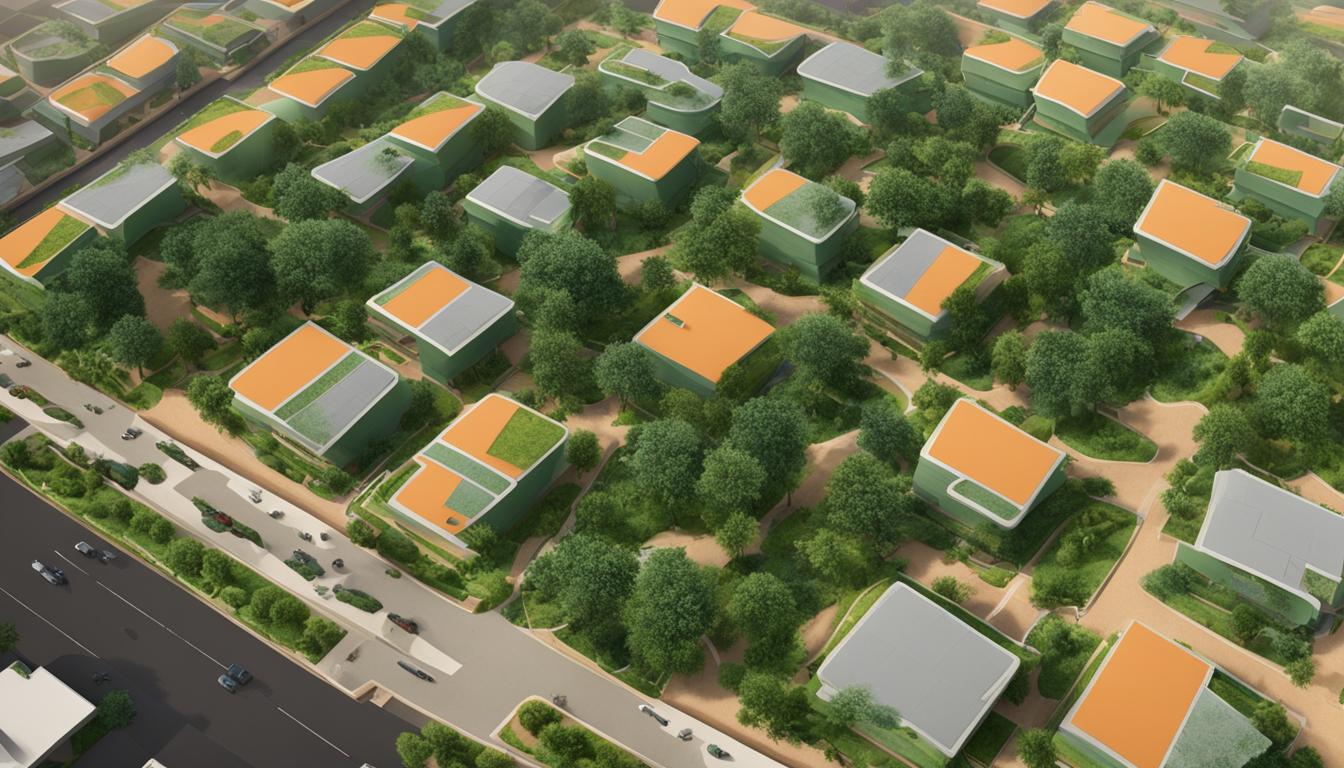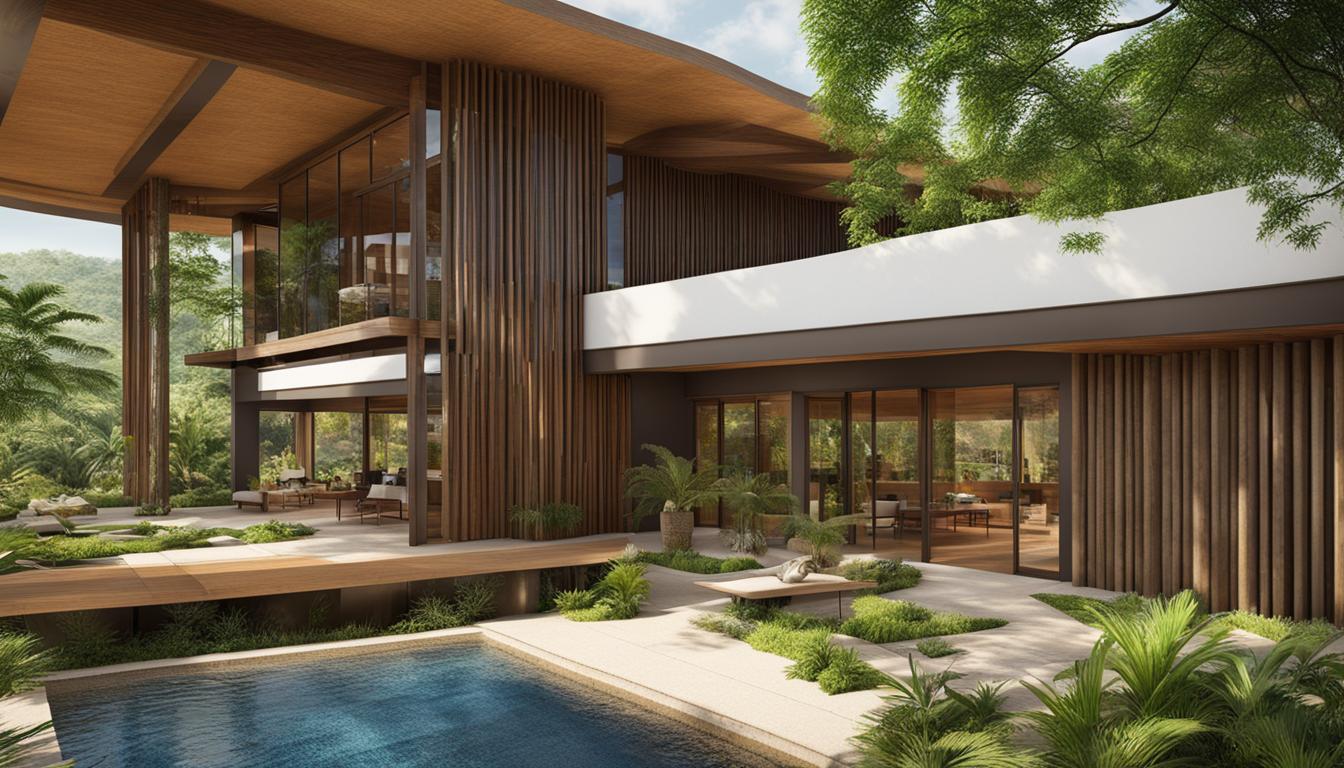Exploring Green Building in Bosnia and Herzegovina – Eco-Friendly
Green building practices have been gaining popularity around the world as countries strive towards sustainable development and reducing the environmental impact of construction. Bosnia and Herzegovina is no exception, with a growing interest in eco-friendly construction methods and sustainable architecture. The country, located in southeastern Europe, is becoming increasingly aware of the importance of reducing its carbon footprint and promoting environmental sustainability in the construction sector.
One of the key aspects of green building in Bosnia and Herzegovina is energy efficiency.
Numerous projects have focused on incorporating energy-saving techniques and materials into the design and construction of buildings. For example, the use of solar panels to generate electricity and heat water has become more common, reducing the reliance on fossil fuels and lowering energy consumption.
Another important aspect of eco-friendly building practices in Bosnia and Herzegovina is the use of sustainable materials. Builders and architects are increasingly opting for locally-sourced and renewable materials, such as timber from managed forests, recycled materials, and natural stone. This not only supports the local economy but also reduces the carbon footprint associated with transporting materials from distant locations.
Water conservation is also a significant factor in green building initiatives in Bosnia and Herzegovina. As the country faces water scarcity issues, implementing rainwater harvesting systems and efficient plumbing fixtures has become crucial. These measures help to minimize water wastage and promote sustainable water management.
Additionally, green building projects in the country often prioritize indoor environmental quality. Designers and builders pay attention to factors such as natural lighting, ventilation, and the use of non-toxic materials. This focus on occupant comfort and health not only contributes to a more sustainable built environment but also enhances the overall well-being of building users.
To promote and support the adoption of green building practices, Bosnia and Herzegovina has seen the emergence of organizations and initiatives dedicated to sustainable construction. These entities offer training programs, certifications, and guidelines to educate professionals and raise awareness about eco-friendly building techniques.
Key Takeaways:
- Bosnia and Herzegovina is embracing green building practices to promote environmental sustainability in the construction sector.
- Energy efficiency, the use of sustainable materials, water conservation, and indoor environmental quality are all important aspects of eco-friendly building practices in the country.
- Local organizations and initiatives are promoting and supporting the adoption of green building practices through education and certification programs.
BiH’s Commitment to Sustainability
Bosnia and Herzegovina, a country located in southeastern Europe, has expressed a strong commitment towards sustainability and green building practices. BiH is aiming to implement sustainable urban planning practices to reduce its carbon footprint and promote a healthy environment for its citizens.
One of the key areas of focus for BiH is the development of renewable energy sources. The country has abundant potential in hydropower and solar energy, which it aims to harness for sustainable electricity production. The government has implemented policies and incentives to encourage the development of renewable energy projects and attract investments in the sector.
Another important aspect of BiH’s commitment to sustainability is waste management. The country is working towards reducing waste generation and promoting recycling and proper waste disposal. Recycling initiatives are being implemented, and awareness campaigns are being conducted to educate the public about the importance of waste management.
BiH is also taking steps to protect its environment and preserve its natural resources. The government is enforcing stricter regulations to prevent pollution and promote sustainable practices. Efforts are being made to preserve forests, protect wildlife, and conserve water resources.
The country’s commitment to sustainability is also evident in its efforts to promote sustainable tourism. BiH is focusing on attracting tourists who are interested in eco-friendly and responsible travel. It is developing eco-tourism initiatives, such as hiking trails and nature parks, to showcase its natural beauty while minimizing the impact on the environment.
Overall, BiH’s commitment to sustainability is driving its efforts in various areas, including renewable energy, waste management, environmental protection, and sustainable tourism. The country’s dedication to green building practices is setting an example for other nations and is essential in ensuring a greener, healthier future for all.

Eco-Friendly Materials and Construction Techniques
In BiH, there is a growing awareness of the importance of using eco-friendly materials and construction techniques. The use of sustainable materials and construction methods has numerous benefits for both the environment and the building occupants.
One of the key aspects of eco-friendly construction is the use of renewable materials. Timber, for example, is a popular choice due to its renewable nature and carbon sequestration properties. Other sustainable materials include bamboo, cork, and recycled materials such as reclaimed wood and recycled steel. By using these materials, builders and architects can reduce their carbon footprint and lessen their impact on the environment.
Eco-friendly construction techniques also play a crucial role in minimizing energy consumption and waste. For example, energy-efficient design principles such as proper insulation and orientation can maximize natural lighting and reduce the need for artificial lighting and heating. Renewable energy systems, such as solar panels and geothermal heating, can also be incorporated to further reduce reliance on non-renewable resources.
Water conservation is another important aspect of eco-friendly construction. Buildings can incorporate low-flow fixtures and rainwater harvesting systems to reduce water consumption. Green roofs and permeable pavements can also help manage stormwater runoff and reduce strain on municipal water systems.
Eco-friendly construction practices also extend to the construction process itself. Recycling and reusing materials, using low-impact construction methods, and proper waste management are all important factors in reducing construction waste. Minimizing air and noise pollution during construction is also crucial for sustainability.
Green buildings not only benefit the environment but also provide numerous advantages to the building occupants. They have better indoor air quality, natural lighting, and thermal comfort, leading to increased occupant health and productivity. Additionally, green buildings often have lower energy and water bills, making them a more cost-effective choice in the long run.
Overall, the use of eco-friendly materials and construction techniques is essential in creating sustainable buildings. By incorporating sustainable materials, energy-efficient design principles, and environmentally-friendly construction practices, builders and architects in BiH can contribute to a greener future while also creating more cost-effective and healthy buildings.

Renewable Energy Integration
BiH has recognized the importance of renewable energy sources and their integration into building design. Renewable Energy Integration is the process of incorporating renewable energy sources into the existing energy grid. It is an important aspect of transitioning towards a more sustainable and environmentally friendly energy system.
The integration of renewable energy sources such as solar, wind, and hydropower involves overcoming various technical, economic, and regulatory challenges. One key challenge in renewable energy integration is ensuring a stable and reliable power supply. Unlike fossil fuel-based power plants, renewable energy sources are often intermittent and dependent on weather conditions. This variability in supply requires the implementation of smart grid technologies and energy storage systems to balance the grid and ensure a continuous power supply.
Another challenge is the need to upgrade and adapt the existing energy infrastructure to accommodate renewable energy sources. This includes transmission and distribution networks, as well as upgrading grid management systems to handle the increased complexity of integrating diverse sources of energy.
Policy and regulatory frameworks play a crucial role in enabling renewable energy integration. Governments need to provide supportive policies, incentives, and regulations that encourage the development and deployment of renewable energy technologies. This includes feed-in tariffs, renewable portfolio standards, and carbon pricing mechanisms to create a level playing field for renewable energy investments.
Renewable energy integration also brings various benefits to the energy system and the broader economy. It reduces dependence on fossil fuels, decreases greenhouse gas emissions, and helps mitigate climate change. Additionally, renewable energy integration can create new jobs, stimulate local economies, and enhance energy security.

In conclusion, Renewable Energy Integration is essential for transitioning towards a sustainable and low-carbon energy system. Overcoming technical, economic, and regulatory challenges is crucial for successfully integrating renewable energy sources into the existing energy grid. With supportive policies and investments in smart grid technologies, the integration of renewable energy can lead to a more resilient, cleaner, and secure energy future.
Green Building Certifications
To encourage and promote eco-friendly construction practices, green building certification programs have been initiated in BiH. These programs aim to promote sustainable building practices and encourage the development of low-carbon footprint buildings. Achieving green building certifications can help buildings to demonstrate their commitment to sustainability and attract environmentally conscious tenants.
One well-known green building certification program is the BREEAM (Building Research Establishment Environmental Assessment Method) certification, which was introduced in the UK in 1990. BREEAM assesses the environmental performance of buildings based on a range of factors, including energy efficiency, water usage, materials used, and indoor environmental quality.
LEED (Leadership in Energy and Environmental Design) is another green building certification program that is widely used across the globe, including in BiH. LEED certification evaluates buildings based on criteria such as sustainable site development, water efficiency, energy and atmosphere, materials and resources, indoor environmental quality, and innovation in design.
In addition to BREEAM and LEED, there are other green building certification programs that are used in Bosnia and Herzegovina, such as the DGNB (German Sustainable Building Council) and HQE (High Environmental Quality).
Green building certifications provide a valuable tool for buildings to demonstrate their commitment to sustainability and their efforts to reduce their environmental impact. By achieving these certifications, buildings can attract tenants who prioritize environmental responsibility and can contribute to the sustainable development of Bosnia and Herzegovina’s built environment.

Local Initiatives and Case Studies
Several local initiatives have been launched in BiH to raise awareness and promote sustainable construction and environmentally-friendly construction techniques. These initiatives serve as inspirational models for others to follow in order to achieve the same positive outcomes.
One noteworthy example is the initiative called “Eko Omladina,” which translates to “Eco Youth.” This youth-led organization focuses on raising awareness amongst the younger generation about environmental sustainability and green building practices. By organizing campaigns, events, and workshops, they aim to encourage young people to take an active role in promoting sustainable development in their communities.
Another example is the “Green Building Council Bosnia and Herzegovina.” This council is committed to promoting sustainable urban planning and green building practices in the country. They offer various training programs, seminars, and events to educate individuals and businesses on how to implement sustainable building practices.
| Image related to Green Building Practices |
|---|
 |
Furthermore, case studies can provide insights into successful local initiatives. One such case study involves the renovation of a historic building in Mostar. Through the use of renewable materials and energy-efficient solutions, the building has been transformed into a low-carbon footprint structure that contributes to the overall sustainability of the city.
Another case study is the construction of the “Eko Selo” eco-village in the village of Lukomir. This village is designed to be self-sustainable and operates off the grid, using renewable energy sources and eco-friendly materials. The eco-village not only promotes sustainable living but also creates employment opportunities for local residents.
“Local initiatives and case studies play a pivotal role in driving positive change at a community level. By showcasing successful models, they inspire others to take action and implement similar initiatives in their own localities.”
These local initiatives and case studies demonstrate the potential for green building practices to drive social, economic, and environmental progress in Bosnia and Herzegovina. By creating sustainable communities, promoting local economic growth, and reducing carbon emissions, these initiatives are setting an example for others to follow and creating a path towards a more sustainable future.
Challenges and Future Outlook
Despite the progress made in green building practices, BiH faces some challenges in fully embracing eco-friendly construction. One of the main challenges is the lack of awareness and understanding of sustainable construction techniques among professionals and the general public. This leads to a reluctance to adopt green building practices and a preference for traditional construction methods that are often detrimental to the environment.
Another challenge is the availability and affordability of eco-friendly materials. Many of these materials are imported, making them expensive and less accessible to the general public. Additionally, the lack of local manufacturing and production facilities hinders their widespread use in construction projects.
The future outlook for green building in Bosnia and Herzegovina is promising, with increasing awareness and commitment to sustainable construction. The government has taken steps towards implementing sustainable urban planning and promoting green infrastructure. However, more needs to be done to incentivize the private sector and individual homeowners to adopt green building practices.
One way to address the challenges is by promoting green building certifications and standards. These certifications can ensure that buildings have a low-carbon footprint and are built with eco-friendly materials and construction techniques. This can provide a competitive advantage for developers and encourage the wider adoption of green building practices.
Local initiatives and case studies have also shown the potential for sustainable construction in Bosnia and Herzegovina. For example, the Sustainable Energy Action Plan project in Tuzla implemented energy-efficient building solutions and renewable energy sources in public buildings. Such initiatives can serve as a model for future projects and inspire more local action towards sustainable construction.
In conclusion, while challenges exist in fully embracing eco-friendly construction in Bosnia and Herzegovina, the future outlook is promising. Continued efforts towards promoting green building practices and increasing awareness can lead to a more sustainable built environment in the country.

Conclusion
Bosnia and Herzegovina has made significant strides in exploring and implementing green building practices. From a commitment to sustainability in urban planning to the use of eco-friendly materials and construction techniques, the country has taken steps towards reducing its carbon footprint and promoting eco-friendly architecture.
Renewable energy integration has also gained traction in Bosnia and Herzegovina, as the country seeks to implement energy-efficient building solutions and green infrastructure. The green building certification programs serve as a recognition of the efforts made towards creating low-carbon footprint buildings.
Local Initiatives and Case Studies
Local initiatives and case studies provide inspiration and encouragement, as they demonstrate the possibilities of sustainable construction and environmentally-friendly construction techniques in Bosnia and Herzegovina. By showcasing successful examples, these initiatives help to spread awareness and drive positive change in the industry.
Despite the progress made, there are still challenges to be faced in the future. The implementation of green building practices may require significant investments and changes to the current construction practices. However, the benefits of creating sustainable and eco-friendly buildings, including lower energy consumption and a healthier environment, make the effort worthwhile.
In conclusion, green building practices have the potential to create a positive impact on the environment and the economy. With its commitment to sustainability and efforts to implement eco-friendly architecture, Bosnia and Herzegovina is on the right track towards a greener future.
FAQ
Q: What is green building?
A: Green building refers to the practice of designing, constructing, and operating buildings in an environmentally responsible and resource-efficient manner. It aims to minimize the negative impact of buildings on the environment and promote sustainable development.
Q: Why is green building important?
A: Green building is important because it helps reduce the environmental impact of buildings, promotes resource conservation, and improves energy efficiency. It also contributes to the well-being and health of occupants and creates a more sustainable and resilient built environment.
Q: What are some eco-friendly materials used in green building?
A: Some eco-friendly materials used in green building include locally sourced timber, natural stone, clay bricks, and recycled materials such as recycled steel and reclaimed wood. These materials have a lower environmental footprint and promote sustainable construction practices.
Q: How does renewable energy integration work in green buildings?
A: Renewable energy integration in green buildings involves the use of renewable energy sources such as solar power, wind power, and biomass to generate electricity and reduce dependency on fossil fuels. This helps reduce carbon emissions and promote a more sustainable energy mix for buildings.
Q: What is a green building certification?
A: A green building certification is a voluntary program that evaluates and certifies buildings based on their sustainability performance. It assesses factors such as energy efficiency, water conservation, materials selection, indoor air quality, and site sustainability. Certifications like LEED (Leadership in Energy and Environmental Design) provide recognition for buildings that meet specific sustainability criteria.
Q: Are there any local initiatives promoting green building in Bosnia and Herzegovina?
A: Yes, there are several local initiatives promoting green building practices in Bosnia and Herzegovina. The Green Building Council (GBC) of BiH is one such initiative that advocates for sustainable construction practices and provides educational programs and resources to professionals in the construction industry. They also offer guidance and support for developers seeking green building certifications.
Q: What are the challenges faced in implementing green building practices in BiH?
A: Some challenges faced in implementing green building practices in Bosnia and Herzegovina include the limited availability and high cost of sustainable materials, as well as a lack of awareness and expertise. However, with increasing awareness and government support, these challenges can be overcome to further promote eco-friendly construction.
Q: What is the future outlook for green building in Bosnia and Herzegovina?
A: The future outlook for green building in Bosnia and Herzegovina is positive. With the government’s commitment to sustainability and the ongoing efforts to promote eco-friendly construction practices, it is expected that the adoption of green building practices will continue to rise. The integration of renewable energy sources and the development of green building certification programs will further drive the transition towards a more sustainable construction industry in BiH.









Bosnia and Herzegovina Top Green Buildings Quick Guide
2 years ago[…] https://constructive-voices.com/green-building-in-bosnia-and-herzegovina/ […]